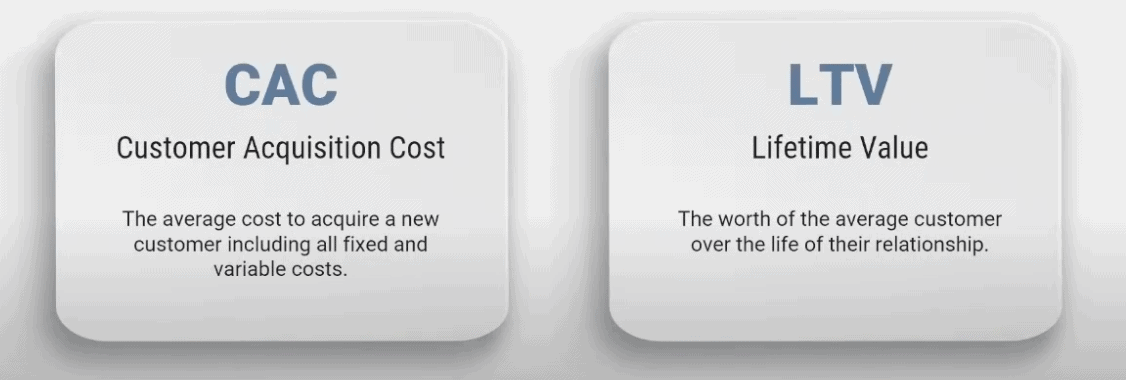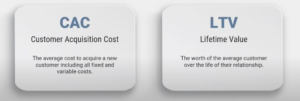The power of measuring customer acquisition cost and lifetime value
Metrics in product marketing are how we can systematically demonstrate return on investment and the value of your team.
So how do we show the impact we’re having using the metrics that matter?
We recommend focusing on two key metrics that will make a difference: customer acquisition cost (CAC) and the average customer’s lifetime value (LTV).
CAC is the average cost to acquire a net new customer. And that includes all fixed and variable expenses, events, personnel, marketing and sales.
The average customer’s lifetime value, or LTV, is how much money each new customer will make for the organization.
How to Calculate Customer Acquisition Cost
This equation involves salaries, commissions, marketing, travel, advertising, media list rentals, distribution and software expenses (which can be significant with expensive programs and bigger teams).
Those elements are added together and divided by the number of net new customers.
Does the CAC equation have to be precisely this at your organization to be effective and accurate?
The answer: no.
This is what we’d call the best practice. The most crucial aspect of measuring CAC is that you need to have alignment and agreement in the entire organization on defining the equation. Consistency over time is the key to ensuring this metric is useful.
The numbers aren’t comparable if you include one expense line item one quarter and exclude it the next quarter.
Another challenge with this equation is defining “net new customer,”, especially for SAS customers.
Does that mean that they have never been a customer with us before? Does it mean they had a break in their contract and then returned? Does it have to be a different division?
All of those are valid questions. But, again, the organization needs to agree on the definition of net new customers and use that approach consistently.
When you track the CAC, you can uncover valuable customer segments and customer segments that might not be worth the investment.
How to Calculate Lifetime Value
All of the revenue you get from a customer should be added together for the lifetime value. That could include subscription revenue, hard sales, professional services, etc.
Of course, you can’t know a total lifetime value because that means they’re done being your customer, which you never want to happen. Instead, these two formulas are how you can examine your overall customer base and trends to predict lifetime value.
Why You Should Measure the CAC to Lifetime Value Ratio
When we’re thinking about lifetime value and customer acquisition costs, they’re really great metrics in isolation, but where that power comes in is when you look at them together.
Every company has a different CAC cost; it’s not a standardized metric. If you have a $1 million product, then a $50,000 CAC is good enough, right? However, if you have a subscription service that is $100 a month and the average tenure of a customer is 13 months, that exact CAC cost would be terrible—it doesn’t work.
You want to measure both metrics, but you want to look at the ratio.
This ratio will tell you if the business is profitable and sustainable. It’ll also help you identify customer segments that aren’t valuable.
What’s the Ideal CAC: LTV Ratio?
Luckily, there is a ton of research on this ratio, and they’ve found a sweet spot between lifetime value being three to four times as much as your CAC.
This is a good benchmark for looking at the efficiency and productivity of your organization. But this ideal ratio is not true for everyone.
Your lifetime value versus customer acquisition costs should depend on where you are as an organization.
If you’re a mature organization where sales and marketing equally drive revenue, you’ll get closer to that ideal lifetime value of three to four times CAC.
If you have a startup where you don’t have an existing market, you will have a heavier sales role in an acquisition. You’re also going to have a much less efficient marketing spend. As a result, you’ll have a much lower ratio. You might have a 1:1 because you’re going after growth. You’re intentionally investing in building a reputation.
If you’re a startup and your ratio is 3:1, you probably aren’t investing enough or expanding as far as you could be.
So, you do want to measure your CAC and your lifetime value, but you also want to focus on the ratio between the two. And it would help if you educate your organization on what these metrics mean.
Unfortunately, teams can get lost and distracted by the metrics that are easy to measure: click-through rates, open rates, landing page views, keyword positioning, SEO rankings.
These metrics are important as indicators. They are suitable for us because we need to refine our programs, but they don’t talk about outcomes. It’s the sum of all of them together is designed to drive CAC and lifetime value.
Rather than simply communicating how to optimize campaigns, you want to share the results and the impact they are having on the organization.
Using CAC:LTV as an Advocacy Tool
If there are conversations at your company to improve revenue, leaders might cut marketing efforts.
When you understand the effect of CAC:LTV, you can speak the board’s and executives’ language by explaining that while cutting marketing efforts will impact revenue at least in the short term; it could also lead to losing out on potential revenue.
This ratio is an advocacy tool for you and your team to explain the effect of reducing investment in product marketing.
Outcomes define the success of product marketing, and the results are what we see with these two metrics and the ratio between the two.
Author
-

The Pragmatic Editorial Team comprises a diverse team of writers, researchers, and subject matter experts. We are trained to share Pragmatic Institute’s insights and useful information to guide product, data, and design professionals on their career development journeys. Pragmatic Institute is the global leader in Product, Data, and Design training and certification programs for working professionals. Since 1993, we’ve issued over 250,000 product management and product marketing certifications to professionals at companies around the globe. For questions or inquiries, please contact [email protected].












